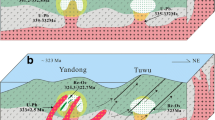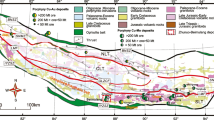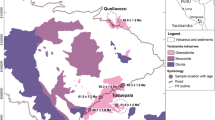Abstract
The Koloula Igneous Complex comprises 26 different intrusive phases that have been divided into two major magmatic episodes — cycle 1 intrusions (≧4.5 Ma) and cycle 2 intrusions (2.4 to 1.5 Ma). The cycle 2 intrusions are further divided into the Inamumu Zoned Pluton (IZP) which is composed of 6 concentrically disposed quartz diorite and tonalite units; and several satellite intrusions. The IZP is host to porphyry-copper mineralization, whereas the cycle 1, and cycle 2 satellite intrusions are barren. Presently exposed mineralization in the IZP (A system) represents the deeply eroded core of a porphyry copper system, where widely-spaced veinlet alteration envelopes (≦ 1 mm thick) are separated by large volumes of unaltered rock.
Compositional trends in biotites and amphiboles from both individual grains and throughout the differentiation series of the IZP, indicate fluctuating but generally increasing \(f_{O_2 }\) existed through the sequence from early magmatic→ late magmatic→ early hydrothermal conditions. In amphiboles, compositional domains (Mg-rich) that are indicative of high \(f_{O_2 }\) are correlated with episodes of fluid exsolution, independent evidence of which is provided by multiple generations of fluid inclusions in quartz phenocrysts. These high \(f_{O_2 }\) domains in amphiboles have higher Si, Mn, and Ca contents, but are depleted in Fe, Ti, Na, K, and Cl relative to the less “oxidizing” domains. The latter elements are those that are known from veinlet alteration assemblages and fluid-inclusion evidence to have been preferentially partitioned into the co-existing fluid phase (≡“late magmatic” hydrothermal solution).
By contrast, amphiboles from barren rock types that are slightly older than, and of the same age as the IZP, exhibit restricted compositional ranges, and are more Fe-rich. Some individual grains and two cycle 2 satellite intrusions indicate Fe-enrichment during progressive crystallization. Siliceous deuteric amphiboles are commonly as Mg-rich as the high \(f_{O_2 }\) amphibole domains from the IZP, but are easily distinguished from them by their lack of smooth compositional trends versus Si, and by their highly variable Mg and Fe contents.
Biotites from the IZP also indicate progressive oxidation, whereas biotites from the barren rock types show either little compositional variation or progressive Fe-enrichment. Biotites from the barren intrusions are richer in Cl, Li and Rb and poorer in Ba than those of the mineralizing intrusions. fHF was very low (∼ 0.003 bars) in both barren and mineralizing intrusions. During progressive differentiation, Rb content decreased and Ba content increased in IZP biotites, which is atypical, yet explicable owing to the former presence of a competing fluid phase during biotite crystallization.
Because \(f_{O_2 }\) is a function of degree of fluid exsolution, then in igneous systems with sufficient Cu, Cl, and ultimately S, progressively higher \(f_{O_2 }\) should potentially lead to more mineralized intrusions. Higher \(f_{O_2 }\) is reflected by steeper ΣFe versus Si gradients in amphibole domains. Indeed, such a graph for amphiboles from 5 igneous complexes, indicates that two economically mineralized units produced steeper Σ Fe∶Si than those from weakly mineralized intrusions. Steep Σ Fe∶Si trends that do not continue to amphibole domains more siliceous than Si=7.3 (atoms per 23 oxygens) are unlikely to have resulted from subsolidus crystallization and these intrusions are unlikely to be strongly mineralized.
Similar content being viewed by others
References
de Albuquerque CAR (1973) Geochemistry of biotites from granitic rocks, northern Portugal. Geochim Cosmochim Acta 37:1779–1802
Barrière M, Cotten J (1979) Biotites and associated minerals as markers of magmatic fractionation and deuteric equilibration in granites. Contrib Mineral Petrol 70:183–192
Boyd FR (1959) Hydrothermal investigations of amphiboles. In: Abelson PH (ed). Researches in geochemistry. John Wiley, New York, pp 377–396
Cawthorn RG (1976) Calcium-poor pyroxene relations in calc-alkaline magmas. Am Mineral 61:907–912
Chaffee MA (1976) The zonal distribution of selected elements above the Kalamazoo porphyry copper deposit, San Manuel district, Pinal County, Arizona. J Geochem Explor 5:145–165
Chivas AR (1976) Magmatic evolution and porphyry copper mineralization of the Koloula Igneous Complex, Guadalcanal. Int Geol Congr 25th, Sydney, 1:48
Chivas AR (1978) Porphyry copper mineralization at the Koloula Igneous Complex, Guadalcanal, Solomon Islands. Econ Geol 73:645–677
Chivas AR (in prep) Geochemical evidence for magmatic fluids in porphyry copper mineralization. III Composition of barren and mineralizing gnintrusions, Koloula Igneous Complex
Chivas AR, McDougall I (1978) Geochronology of the Koloula porphyry copper prospect, Guadalcanal, Solomon Islands. Econ Geol 73:678–689
Chivas AR, Wilkins RWT (1977) Fluid inclusion studies in relation to hydrothermal alteration and mineralization at the Koloula porphyry copper prospect, Guadalcanal. Econ Geol 72:153–169
Czamanske GK, Wones DR (1973) Oxidation during magmatic differentiation, Finnmarka Complex, Oslo area, Norway. Part 2. The mafic silicates. J Petrol 14:349–380
Feiss PG (1978) Magmatic sources of copper in porphyry copper deposits. Econ Geol 73:397–404
Godfrey JD (1962) The deuterium content of hydrous minerals from the east-central Sierra Nevada and Yosemite National Park. Geochim Cosmochim Acta 26:1215–1245
Grapes RH (1977) Chemical inhomogeneity of amphiboles in relation to section orientation in routine EPMA analysis. Geochem J 11:253–255
Hards N (1976) Distribution of elements between the fluid phase and silicate melt phase of granites and nepheline syenite. In: Biggar GM (ed). Progress in experimental petrology 3:88–91 Natural Environ Res Council
Harry WT (1950) Aluminium replacing silicon in some silicate lattices. Mineralog Mag 29:142–149
Helz RT (1973) Phase relations of basalts in their melting range at PH2O=5 kb as a function of oxygen fugacity. Part I. Mafic phases. J Petrol 14:249–302
Hendry DAF, Chivas AR, Reed SJB, Long JVP (1981) Geochemical evidence for magmatic fluids in porphyry copper mineralization. II. Ion-probe analysis of Cu contents of mafic minerals, Koloula Igneous Complex. Contrib Mineral Petrol 78:404–412
Jakeš P. White AJR (1972) Hornblendes from calc-alkaline volcanic rocks of island arcs and continental margins. Am Mineral 57:887–902
Kesler SE, Issigonis MJ, Brownlow AH, Damon PE, Moore WJ, Northcote KE, Preto VA (1975) Geochemistry of biotites from mineralized and barren intrusive systems. Econ Geol 70:559–567
Kilinc IA, Burnham CW (1972) Partitioning of chloride between a silicate melt and coexisting aqueous phase from 2 to 8 kilobars. Econ Geol 67:231–235
Kuroda Y, Hariya Y, Suzuoki T, Matsuo S (1975) Pressure effect on water content of amphiboles. Geophys Res Lett 2:529–531
Leake BE (1971) On aluminous and edenitic hornblendes. Mineral Mag 38:389–407
Leake BE (1978) Nomenclature of amphiboles. Am Mineral 63:1023–1052
Ludington S (1978) The biotite-apatite geothermometer revisited. Am Mineral 63:551–553
Mason DR (1978) Compositional variations in ferromagnesian minerals from porphyry copper-generating and barren intrusions of the Western Highlands, Papua New Guinea. Econ Geol 73:878–890
Munoz JL, Ludington SD (1974) Fluoride-hydroxyl exchange in biotite. Am J Sci 274:396–413
Nockolds SR, Mitchell RL (1948) The geochemistry of some Caledonian plutonic rocks: a study in the relationship between the major and trace elements of igneous rocks and their minerals. Trans R Soc Edinburgh 61:535–575
Reed SJB, Ware NG (1973) Quantitative electron microprobe analysis using a lithium-drifted silicon detector. X-ray Spectrom 2:69–74
Reed SJB, Ware NG (1975) Quantitative electron microprobe analysis of silicates using energy-dispersive X-ray spectrometry. J Petrol 16:499–529
Ryabchikov ID (1963) Experimental study of the distribution of alkali elements between immiscible silicate and chloride melts. Dokl Akad Nauk SSSR 149:190–192
Ryabchikov ID, Wall VJ, Burnham CW (1974) Equilibria of oreforming fluids with acid magmatic rocks (in Russian). Geol Rudn Mest 16 (3):15–26
Soregaroli AE (1974) Geology of the Brenda copper-molybdenum deposit in British Columbia. Can Inst Min Metall Bull 67 (750):76–83
Stringham B (1960) Differences between barren and productive intrusive porphyries. Econ Geol 55:1622–1630
Tanaka H (1975) Magnesium-iron distribution in coexisting biotite and hornblende from granitic rocks. J Jap Assoc Mineral Petrol Econ Geol 70:118–124
Wilson AD (1955) A new method for the determination of ferrous iron in rocks and minerals. Bull Geol Surv Great Britain 9:56–58
Wones DR, Eugster HP (1965) Stability of biotite: experiment, theory and application. Am Mineral 50:1228–1272
Author information
Authors and Affiliations
Rights and permissions
About this article
Cite this article
Chivas, A.R. Geochemical evidence for magmatic fluids in porphyry copper mineralization. Contr. Mineral. and Petrol. 78, 389–403 (1982). https://doi.org/10.1007/BF00375201
Received:
Accepted:
Issue Date:
DOI: https://doi.org/10.1007/BF00375201




